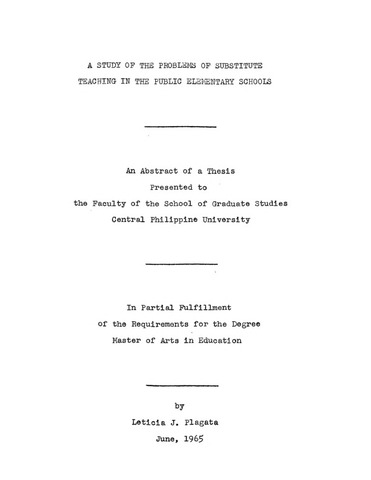Показать сокращенную информацию
A study of the problems of substitute teaching in the public elementary schools
| dc.contributor.adviser | Griño, Eliza U. | |
| dc.contributor.author | Plagata, Leticia J. | |
| dc.coverage.spatial | Iloilo | en_US |
| dc.date.accessioned | 2021-12-01T00:38:18Z | |
| dc.date.available | 2021-12-01T00:38:18Z | |
| dc.date.issued | 1965 | |
| dc.identifier.citation | Plagata, L. J. (1965). A study of the problems of substitute teaching in the public elementary schools (Unpublished Master’s thesis). Central Philippine University, Jaro, Iloilo City. | en_US |
| dc.identifier.uri | https://hdl.handle.net/20.500.12852/1729 | |
| dc.description | Abstract only | en_US |
| dc.description.abstract | The root cause of persistent problems in substitute teaching is teacher absenteeism. The effects of these problems were especially felt in the teaching-learning process when a class changed teachers. Concomitant problems also involved what preparation to demand from the substitute for her work and how to help her meet the problems particular to it. The sources of data for this report were the official records on leaves and absences in the Division of the Iloilo City Elementary Schools, circulars, books, and periodicals relevant to substitute teaching, and a questionnaire-survey of principals and regular and substitute teachers of the Division. Absences and leaves were totaled, reduced to the number of days or months and averaged. The responses of the school personnel to their respective questionnaires were tallied, summarized, and interpreted. From all these data it was found that although problems of substitute teaching do exist, they have not been recognized as such. The absence of a definite program for substitute teaching in the public schools was already an indication of this attitude. Some of the other findings are: (1) Substitutes were not provided for short-term absences although an amount corresponding to an absence was deducted from a regular teacher's salary. It would seem that all the substitute teaching provided in the school system was for protracted and official leaves of absence and consists only in putting a teacher in the vacancy created by a teacher on leave. This arrangement had generated problems that directly or indirectly concerned the efficiency of teaching and the quality of instruction. (2) Teachers did and do get absent. Findings show that there was rarely a school day in which no teacher was absent. It was further found that the average number of teachers for the ten schools in the three years included in this study was 385, of which an average of 8.4% or 32.34 teachers were absent a month. (3) The fact that there seemed to be no official requirement for teachers to inform their principals before hand of their absence meant that there were a number of absences that it was too late to have made arrangements for before the absences occurred. (4) The dearth of literature on substitute teaching indicates that substitutes do not even seem to have status as an entity in the educational field, although their services are inevitable and their work is undoubtedly more exacting and demanding. The recommendations were indicated by the findings revealed in this report and also born of this researcher’s impressions from personal observations and experience as a public school teacher. This investigation has established the necessity of setting up in the division a permanent substitute service of some kind. Permanent substitutes, when not busy, could be utilized to coach slow-learners, do office work, or do other school work needing extra help. One-half to one-day absences could be taken care of by neighboring regular teachers themselves. An alternative to this proposal is to have a sort of "teacher-pool" in either the school or the division, the members of which could be available at a moment's notice. It is also recommended that we follow practices else where of granting teachers at least ten days of absence with pay a year, for reasons of illness at least. Contrary to the general idea, teachers, especially substitutes, should preferable be male. Permanent substitutes should be versatile and experienced ones who are young enough to be still energetic and efficient. It is suggested that the Division take cognizance of its particular need for a substitute service and organize one in the soonest possible time. Explicit and clear instructions should pass from regular to substitute and vice versa when a class passes from one to the other upon the start or termination of a leave. The preparation and issuance of a sort of substitute handbook or bulletin by the substitute service is also deemed necessary. Findings indicate more need for substitutes for academic subjects like Language, Arts and Social Studies and for Grade One. It is further recommended that in-service training programs for substitutes in their respective fields be held for them. The need for this training is especially indicated for Music. | en_US |
| dc.format.extent | 173 leaves | en_US |
| dc.language.iso | en | en_US |
| dc.subject.ddc | GSL Theses 378.242 P691 | en_US |
| dc.subject.lcsh | Substitute teaching | en_US |
| dc.subject.lcsh | Substitute teachers | en_US |
| dc.subject.lcsh | Public schools | en_US |
| dc.subject.lcsh | Elementary schools | en_US |
| dc.subject.lcsh | Teachers--Leaves of absence | en_US |
| dc.subject.lcsh | Education, Elementary | en_US |
| dc.subject.lcsh | Philippines--Iloilo | en_US |
| dc.title | A study of the problems of substitute teaching in the public elementary schools | en_US |
| dc.type | Thesis | en_US |
| dc.description.bibliographicalreferences | Includes bibliographical references | en_US |
| dc.contributor.chair | Nelson, Linnea A. | |
| dc.contributor.committeemember | Sornito, Juan E. | |
| dc.contributor.committeemember | Revicencio, Patria J. | |
| dc.contributor.committeemember | Caipang, Majella V. | |
| dc.contributor.committeemember | Salzman, Esther I. | |
| dc.contributor.department | School of Graduate Studies | en_US |
| dc.description.degree | Master of Arts in Education | en_US |


